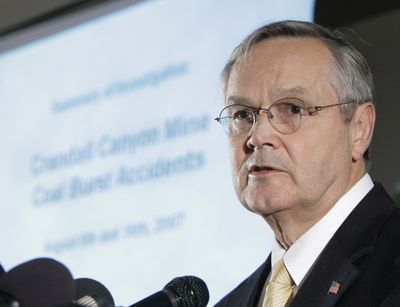Report faults Utah mine operator
Federal agency issues findings on deadly collapse last year

PRICE, Utah – The operator of a collapsed Utah mine violated safety protocols by cutting coal pillars that should have been left standing to prevent cave-ins, federal regulators said Thursday.
The officials said a subsidiary of Ohio-based Murray Energy Corp. undermined other pillars by excavating coal from tunnel floors. They also faulted the company’s engineering firm, Agapito Associates Inc. of Grand Junction, Colo., for conducting a flawed evaluation of mining dangers.
Murray Energy chief Bob Murray has insisted that taking down the pillars, a practice called retreat mining, had nothing to do with the collapse. He argued from the start that it was caused by an earthquake.
At a news conference Thursday, Mine Safety and Health Administration chief Richard Stickler disputed that, instead blaming poor engineering.
“First of all, it was not – and I’ll repeat not – a natural occurring earthquake, but in fact it was a catastrophic outburst of the coal pillars that were used to support the ground above the coal seam,” Stickler said.
The agency is fining Murray Energy affiliate Genwal Resources Inc. $1.6 million and Agapito $220,000 for the disaster – the largest fines ever imposed on a U.S. coal mining operation, he said.
The Aug. 6 collapse trapped six miners whose bodies haven’t been recovered. Three others were killed during a rescue attempt.
MSHA said Genwal Resources misled regulators about the dangers and violated its approved mining plan.
Genwal responded in a lengthy statement contending “politics” and congressional meddling corrupted the MSHA investigation. “This report does not have the benefit of all of the facts and appears to have been tainted by ten months of relentless political clamoring to lay blame for these tragic events,” the company said.
The MSHA report confirmed congressional investigations that faulted Genwal for courting danger at the mine.
Internal company memos revealed that the company was digging into massive blocks of coal that should have been left standing to hold the mine up, according to a March report issued by the Senate Health, Education, Labor and Pensions Committee.
The report found that the company was excavating coal from tunnel floors, undermining other coal pillars straining under the tremendous weight of the mountain. MSHA’s report said the operator didn’t have permission to mine the “bottom coal.” Yet internal company memos made no secret of the practice.